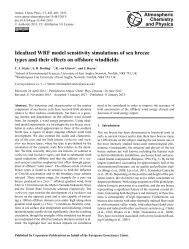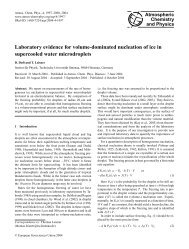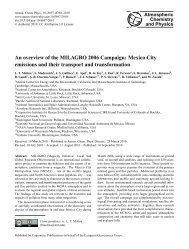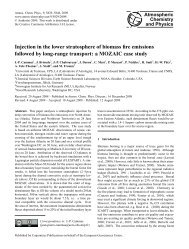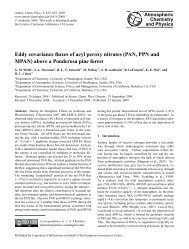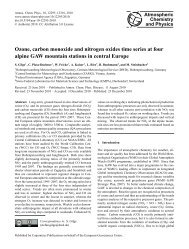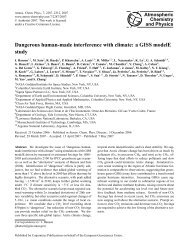A modified band approach for the accurate calculation of online ...
A modified band approach for the accurate calculation of online ...
A modified band approach for the accurate calculation of online ...
Create successful ePaper yourself
Turn your PDF publications into a flip-book with our unique Google optimized e-Paper software.
4158 J. E.Williams et al.: Online photolysis in Chemical Transport Models<br />
Fig. 16. As <strong>for</strong> Fig.15 except plots are shown <strong>for</strong> (a) N2O, (b) Cl2O2, (c) BrO, and (d) CFC12 with respect to <strong>the</strong> incident θ <strong>for</strong> <strong>the</strong> middle<br />
and upper atmosphere.<br />
with ∼3% <strong>for</strong> <strong>the</strong> lowest few layers <strong>of</strong> <strong>the</strong> atmosphere).<br />
For scenarios which include cloud and aerosols, <strong>the</strong>re are<br />
similarities in <strong>the</strong> change in <strong>the</strong> distribution <strong>of</strong> <strong>the</strong> error budgets<br />
as those discussed in Sect. 4.3. Associated errors <strong>of</strong> between<br />
5–10% exist from 0–25 km <strong>for</strong> all <strong>the</strong> additional tropospheric<br />
species except JCH4CO, which has similar <strong>band</strong> contribution<br />
as <strong>for</strong> JO3 (→O1 D) and thus exhibits an increase<br />
in <strong>the</strong> lowest layer at θ=82 ◦ . For <strong>the</strong> additional stratospheric<br />
species <strong>the</strong>re is only a minimal effect on <strong>the</strong> associated errors<br />
compared to <strong>the</strong> clear-sky scenario discussed above, similar<br />
to <strong>the</strong> differences shown between Figs. 11 and 16.<br />
5.2 The feasibility <strong>of</strong> future updates<br />
The photolysis scheme presented here has been specifically<br />
designed to calculate height resolved J values <strong>for</strong> chemical<br />
species which are photolytically important to <strong>the</strong> chemical<br />
composition <strong>of</strong> <strong>the</strong> troposphere and stratosphere. There<strong>for</strong>e,<br />
if one wished to use such a scheme <strong>for</strong> a model which focuses<br />
purely on <strong>the</strong> troposphere, where <strong>the</strong> photolysis <strong>of</strong> species<br />
such as, <strong>for</strong> example, <strong>the</strong> CFC’s and N2O are not important,<br />
<strong>the</strong>n modifications could be made to <strong>the</strong> <strong>approach</strong> (e.g. <strong>the</strong><br />
removal <strong>of</strong> <strong>band</strong> 1). It should be noted that <strong>for</strong> any additional<br />
species <strong>the</strong> associated error depends on which <strong>band</strong>s<br />
contribute to <strong>the</strong> final J value. Chemical species with absorption<br />
maxima at λ>305.5 nm will have ra<strong>the</strong>r small associated<br />
errors, such as e.g. dimethyl sulfide (DMS). Moreover,<br />
new values <strong>for</strong> <strong>the</strong> photolytic parameters (σx and φx) can be<br />
easily implemented into <strong>the</strong> scheme due to <strong>the</strong> transparent<br />
nature in which <strong>the</strong> scheme has been designed (i.e.) by simply<br />
updating <strong>the</strong> look-up table by interpolating <strong>the</strong> updated<br />
values onto <strong>the</strong> working grid.<br />
The application <strong>of</strong> <strong>the</strong> pseudo-spherical approximation to<br />
<strong>the</strong> two-stream method adopted in this work <strong>for</strong> high zenith<br />
angles should be considered to be a pragmatic way in which<br />
to improve twilight photolysis rates when <strong>the</strong> use <strong>of</strong> more<br />
complex RT solvers is not feasible. The <strong>band</strong> <strong>approach</strong> has<br />
a limitation in that <strong>the</strong> per<strong>for</strong>mance depends on <strong>the</strong> use <strong>of</strong> a<br />
Atmos. Chem. Phys., 6, 4137–4161, 2006 www.atmos-chem-phys.net/6/4137/2006/



